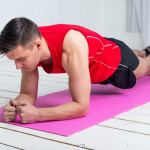 Body weight exercises are your best friend for a home workout. Start with a warm-up that includes jumping jacks, high knees, and butt kicks. Some effective leg exercises include squats, lunges, and glute bridges. To strengthen your core and upper body you can do planks, sit-ups, bicycles, and push-ups. If you are unsure what some of these exercises are, or are interested in learning new exercises, check out YouTube. Many certified personal trainers will post step by step videos, which is helpful if you are new to strength training. It can also be helpful to work out in front of a full-length mirror, so that you can check your form.
Body weight exercises are your best friend for a home workout. Start with a warm-up that includes jumping jacks, high knees, and butt kicks. Some effective leg exercises include squats, lunges, and glute bridges. To strengthen your core and upper body you can do planks, sit-ups, bicycles, and push-ups. If you are unsure what some of these exercises are, or are interested in learning new exercises, check out YouTube. Many certified personal trainers will post step by step videos, which is helpful if you are new to strength training. It can also be helpful to work out in front of a full-length mirror, so that you can check your form.
Body weight training will help you build strength, but for more advanced muscle building, you may be interested in using weights with these exercises. Joining a gym is a great way to have access to a variety of weights and equipment. Going to the gym can feel uncomfortable at first; however, it can be helpful to go with a friend or work with a trainer for a couple sessions. If you do not have access to weights at home, you can use household objects as weights, like soup cans, water bottles, or bags of rice.
Additionally, your nutrition is important when trying to build muscle. It’s important to eat a balance of all the food groups: grains, protein, fruit, vegetables, dairy, and healthy fats. When exercising, your pre- and post- workout meals are important. Aim to eat a carbohydrate-based snack before exercising to give you immediate energy, and a carbohydrate/protein snack or meal after exercising, to help repair your muscles. Hydration is also key! Males should get 120 ounces of fluid per day, but this also takes into account liquids such as coffee and milk, and fluid from watery fruits (ex. watermelon) and vegetables. Aim to drink 8-16 ounces of water before you exercise, and drink water throughout your workout and after as well. You will know you are hydrated if your urine is a pale-yellow color.
 Young Men's Health
Young Men's Health